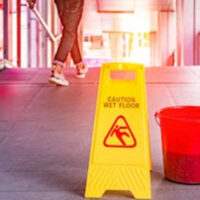What Do I Need To Prove In A Slip And Fall Case?

If you were ever injured in a slip and fall accident while on the premises of another, you may have considered filing a personal injury lawsuit against the property owner or other liable party. The following article will provide some information regarding the standard of proof in these kinds of cases.
What is premises liability?
Premises liability is a legal concept, based in personal injury law, which alleges that an injury a person sustained resulted from a defective condition on the premises of another (for example, a store owner, landlord, etc.). Regarding slip and fall accidents, the person injured is alleging that she slipped and fell and suffered resulting injuries due to a defective condition (such as wet floors, unsecured rugs, or loose steps).
What do I need to prove in a premises liability case based on a slip and fall accident?
In order to make a successful premises liability claim based on a slip and fall accident, you will need to show proof of the following elements:
- A dangerous condition existed on the premises at the time of the accident. It is important in these cases to be able to show that there was a defective or dangerous condition somewhere on the premises at the time that you were injured. As previously mentioned, this could be evidence of a wet floor, a loose floorboard, or some other defective condition on the premises. If possible, you should take pictures or otherwise document the defective or dangerous condition immediately after the accident to prove the existence of this condition at the time the accident occurred.
- The property owner knew (or should have known) of the dangerous condition. This element can be proven by providing some type of evidence that the owner had reason to know of the existence of the dangerous condition. For example, if an employee reported a large spill to the owner, this is likely sufficient to show that the owner had proper notice of the dangerous condition.
- The property owner failed to take reasonable care to protect people from the dangerous condition on the premises. If the owner becomes aware of a defective condition on his premises but fails to take the proper actions to rectify or warn others of the defective condition, he will be liable for a person’s resulting injuries. Using the previous example, if the owner knew of the spill but took no action and subsequently someone slipped in the spill and fell, the owner would be liable for that person’s resulting injuries.
- As of a result of this failure, someone on the premises was injured (via slip and fall) by the defective condition. If an owner fails to take reasonable care to protect people from a dangerous condition on his premises that he was aware of (or reasonably should have been aware of) and someone suffers a slip and fall injury, this element is satisfied.
Do You Have a Potential Premises Liability Personal Injury Claim? Speak to an Ocala Personal Injury Attorney
If you have a potential premises liability claim based on a slip and fall accident, please don’t hesitate to contact The Musleh Law Firm. Our experienced Ocala personal injury attorneys will fight to ensure that you receive proper compensation for any injuries you have sustained, as well as any damages you may have suffered.

